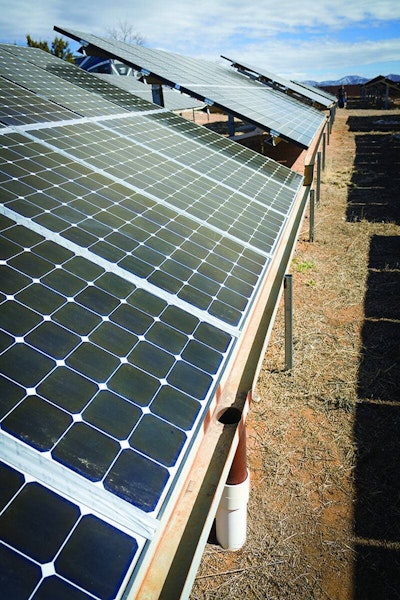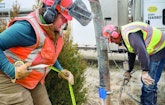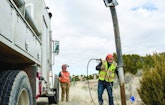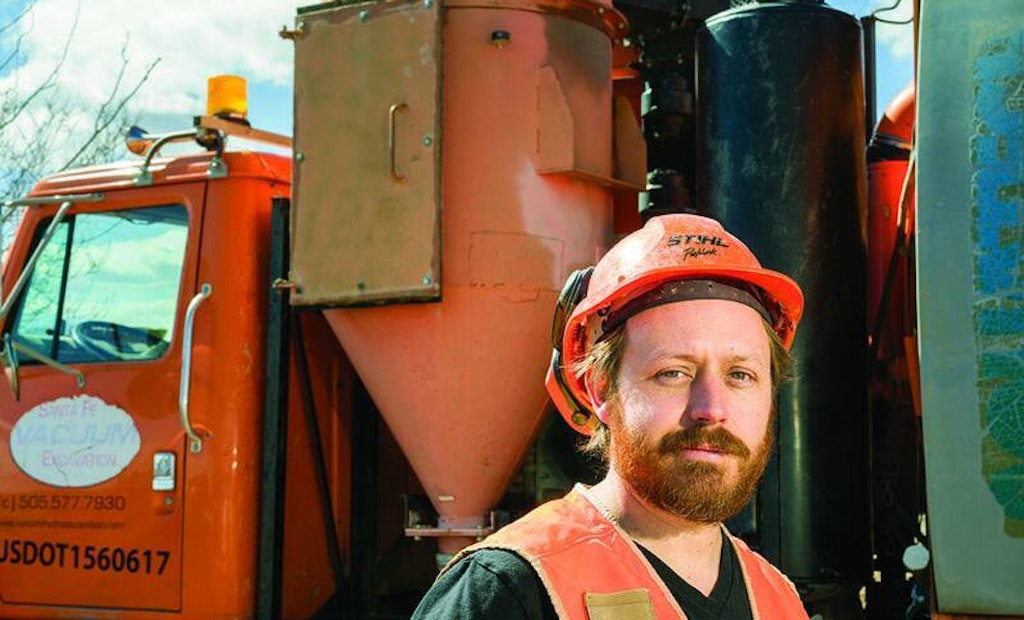Interested in Vacuum Excavation?
Get Vacuum Excavation articles, news and videos right in your inbox! Sign up now.
Vacuum Excavation + Get AlertsSanta Fe Vacuum Excavation is a relatively small company — “boutique” is how the owner characterizes it — but a company with a firm grasp on the big picture. That is, getting bigger is not as important to company ownership as getting it right.
In 2019, the then-13-year-old New Mexico company reached a stage of its development that had Tim Brown seriously considering expanding its service area to the entire state. The company had grown up in and around Santa Fe and Albuquerque, cities an hour apart. But after COVID arrived that year, Brown and his father, John Brown, revisited the idea.
The senior Brown founded the company. His son joined it and today owns the company’s vac trucks and manages its operations. Two factors came into play in their decision not to go statewide.
First, the economic impact of the pandemic was unclear, which made expansion more problematic than it otherwise would have been. Second, Tim Brown’s wife was about to deliver a child and he concluded it was a good time to pull back a little from working out in the field and thereby lessen their exposure to the rampant virus.
Pulling back proved a good decision. “I have never been happier than I am operating as a boutique Santa Fe vacuum excavation company,” says Tim Brown. “As it turned out, the highest demand for our services we ever experienced was that year. I was sort of forced into the managerial decision of getting out of my pickup and reaching customers on the phone and now I’m seldom in the field.”
STARTING WITH SAFETY
Before Santa Fe Vacuum Excavation came into being, John Brown had worked for years in the construction field as a general contractor, remodeling and building spec houses. He also got involved in a recreational vehicle park on property that Brown family forebearers had homesteaded near Santa Fe generations ago. To keep the property in the family and intact, rather than subdivide it, Brown proposed building a 100-unit RV park.
Snowbirds from northern states and other part-time residents flock to the region — and to the park — from Thanksgiving through the middle of March. RV park revenue is what Tim Brown calls an economic “shock absorber” for the family businesses, including the vacuum excavation company.
When the housing market worsened, the senior Brown looked for more stable employment beyond homebuilding and learned of an opening with the area OSHA office. Because he was very interested in workplace safety, Brown quit contracting and segued into safety management. He worked at OSHA for eight years before leaving to become safety director for one of the larger general contractors in New Mexico and the region, Bradbury Stamm Construction. Semiretired now, Brown is still retained by the construction company as a safety consultant.
In 2007, Brown realized that what Bradbury Stamm needed to safely excavate deep below a street was a vacuum excavator. When the contractor declined to purchase such a rig, Brown did to prove the technology’s effectiveness. He hired his son to operate the vac truck and started his company. Brown believes the truck was the first brought into New Mexico for vacuum work outside of use in oil fields.
The rig was a used 1997 Aquatech hydrovac rig (Hi-Vac Corporation) bought in auction in Atlanta. “That truck cost us $80,000 and we put another $5,000 in it,” Tim Brown recalls. “On the very first job we did with it, we made about $10,000 and said to ourselves, ‘This could work.’”
For a while, the Aquatech B-10 combo truck practically lived in the Albuquerque wastewater treatment plant, a facility where new lines regularly were being laid and old ones repaired.
ADDING EQUIPMENT
The company currently has three Aquatech hydrovac rigs, a VACMASTERS SYSTEM 4000 and a SmartVac tandem unit. Unless a large project requires it, only two or three of the vehicles roll out for customer calls, the other two remaining on standby. The company has hung on to the original rig because it is worth more in reserve than it would bring from a buyer, says Tim Brown.
“It runs great, but if it does break down, we probably can fix it. The newer trucks can’t do that. To us the truck is worth at least $40,000, but people are afraid to buy it because it’s old. If you go to trade it in, they’ll only give us $10,000.” So, the B-10 keeps doing its thing as needed.
Santa Fe Vacuum Excavation has four employees, three of whom the company sent to school to earn their commercial driver’s licenses so they could fully operate the trucks. One of the operators has worked for the company for 10 of its 16 years.
While both hydrovac and air-vac excavations are offered, most of the company’s work is with water. Brown prefers it that way.
“Water moves the dirt faster, the dirt goes in the truck smoother, fewer dust particles are floating in the air with water,” he says. “And an air truck is a hot truck. Our operators sometimes get splashed when they’re using water and on a hot day in the summer in New Mexico that feels good.”
The company’s newest rig — the SmartVac — is working well but actually wasn’t the model Brown wanted to procure. The order for the truck was sent in right before COVID generally interrupted manufacturing assembly lines. Consequently, Brown ended up with a slightly larger vac on a Peterbilt chassis than the envisioned smaller unit on a Freightliner chassis.
“We wanted a smaller, single-axle truck with a smaller tank and the standard blower and boom,” Brown recalls. “You go to the WWETT shows and they exhibit those triple-axle monsters, which are great for oil fields in the middle of nowhere. They don’t make sense in Santa Fe, though. So much of the city is donkey trails that were paved. There’s no room.”
TRICKY, TRICKY
The Santa Fe company declares on the homepage of its website that it specializes in tricky jobs. Brown was asked how he defines “tricky.” In response he talked about the company’s experience removing elevator jacks from shafts in Albuquerque and elsewhere.
The two- and three-story buildings have elevators that operate on hydraulic jacks instead of cable systems. When the buildings were constructed, the jacks were set in place and the area around them backfilled — including with construction waste. Replacing the jacking mechanism requires removing the backfill and that’s when the vacuum excavation units are called to suck out the material and into barrels for carting away.
“On a freight elevator in El Paso, the top of the jack was 25 feet below where the truck was parked — some 150 feet away from the elevator shaft — with the jack running down another 55 feet. We had pulleys and cables to move stuff around and a flashlight on a rope to see down into this hole maybe three feet in diameter,” Brown recalls. “We sent down a magnet to lift out some parts. Plus, the jack had failed and leaked hydraulic oil, saturating the surrounding sand. It was sticky, sticky stuff.”
The company vacuumed out 28 elevator shafts in Albuquerque alone. “We got really good at it,” he recalls, “and then we ran out of work.” No more elevator jacks needed replacing.
Another “tricky” job successfully undertaken was even trickier. It was at an abandoned uranium strip mine where authorities needed soil samples for radioactive half-life testing. The samples were required from the bottom of a pit, which had partially filled with water.
“So how do you do that?” Brown rhetorically asks. The answer was construction of a plywood barge that floated on Styrofoam blocks 3-foot-by-4-foot-by-8-foot in size, with a lift at one end of the barge along with other mechanisms. The soil was sucked up and into barrels on the barge. Vacuum for the system was generated by an Aquatech truck located more than a thousand feet from the sampling sites, with the suction ultimately delivered through 4-inch PVC pipe floated on the water.
From such successful vacuuming tasks was a reputation built. Yet occasionally an assignment will daunt Brown and his operators. Case in point: A culvert near a mine.
One of their staple services is jetting culverts that the state’s sandy soils have filled up. A 12-foot-in-diameter, 300-foot-long culvert near Silver City required two weeks of jetting to remove the soil. In the course of removal, however, the soil became impenetrable by water. Mined granite material had washed down into it and proved immoveable.
“That gravel was not normal,” Brown says. “It was sharp like glass and interlocked like Legos. After we had jetted there a while, it sort of settled into a mosaic mass and water could no longer penetrate it.” A directional drill was hauled in to break apart the gravel for vacuuming. “We realized that if we hadn’t jetted it, it never would have settled that way.”
MORE THAN VACUUMING
Trigger Warning: Tim Brown is not a vacuum excavation purist. Among his pieces of equipment is an ultra-compact excavator, a Kubota 008, the smallest hydraulic digger Kubota makes. It is a useful backup to the air and wet vacs. “If we are only doing potholing or something, we wouldn’t need it, but it is a cool tool.”
The hydraulic and air-vac excavation systems combined imaginatively in a backyard in Santa Fe where a woman wanted a rain cistern dug in caliche clay. Normal equipment access to the small property was impossible. So, Brown narrowed the moveable rubber treads on the Kubota and drove it through the house’s 36-inch doorways into the backyard.
Then, to minimize the woman’s costs, he rented her the Kubota 10 HP machine and she and her granddaughter excavated the cistern themselves. Soil they dug up was dumped onto a screen and then into a 6-inch vacuum line that ran 35 feet through the house to the vacuum excavator parked outside. “It took them about two weeks, but we talked her through it and they dug it themselves.”
That job illustrates another facet of Santa Fe Vacuum Excavation: Brown is selective about jobs he takes on — in keeping with his boutique business model. He is, in fact, willing to rent out equipment and to act as a paid consultant on a job rather than bid a job itself. “I tell some customers, ‘Look, I’ll be a consultant for $300 and tell you how to do a job. If I end up doing the job myself, I’ll knock $300 off the price of doing it.’”
The company also has shoring materials which it will rent out and consult with a customer about using the materials. “Sometimes a company calls and we talk and I learn there aren’t any utilities in the area, so they don’t need a vac truck. They don’t need us. What they need is understanding how to do shoring. I know sometimes it looks like we talk ourselves out of jobs, but that upfront approach is why we get jobs.”
LOOKING AHEAD
The 37-year-old Brown may not be thinking about going statewide with the company’s services, but that doesn’t mean his interest in new vacuum excavation machinery is gone. Besides his interest in smaller vac trucks for navigating tight spaces, he’s eyeing some bigger rigs.
For example, he admires the engineering on an MTS dry vac, a German vacuum brand. It features a patented twin-fan system, a 10-inch boom that incorporates a vibrator to keep dirt moving and a high-dump configuration for unloading into a dumpster. “It’s a massive beast and I would have to do a lot of digging to utilize it.”
Then there’s an Italian-made stainless steel hydrovac with a water filtering and recycling unit. “They say they can pothole all day using just a 200-gallon water tank. Or pothole all day with 200 gallons of water,” Brown says with evident enthusiasm for the technology.
Brown is his father’s son, though, and conveys just as much interest in safe operation as he does in efficient operation. After all, as he points out, they should be one and the same.
“The biggest goal of safely operating a piece of machinery is to do a job better and faster,” Brown says. “Being safe shouldn’t inhibit production but encourage it.”
He goes over safety rules with his employees before each job, emphasizing those that apply to a task at hand. But his overall counsel to them is, don’t put yourself in an unsafe position to begin with. “My dad’s safety approach has been to remove the risk in advance, if possible. Don’t create confined spaces. Don’t put yourself in a hole where you need shoring to protect you.”
The son clearly admires the father in the Brown family, but it is a two-way salute. John Brown says his son is a gifted manager of the vac fleet because he retains everything he learns on a job.
“In his first 13 years running trucks and doing the work, Tim learned and seemed to remember every different situation,” John Brown says. “He has it in his head now like a library.” Stuff like what kind of dirt vac truck operators will find here or there, where rock lurks three feet underground, how a certain kind of surface valve connects to lines underground.
This valuable “library” of accumulated understanding gives Tim Brown — and the company — an edge in bidding jobs and on guiding truck operators in their work. “It’s amazing,” John Brown says. “I call him the Sherlock Holmes of utilities.”











